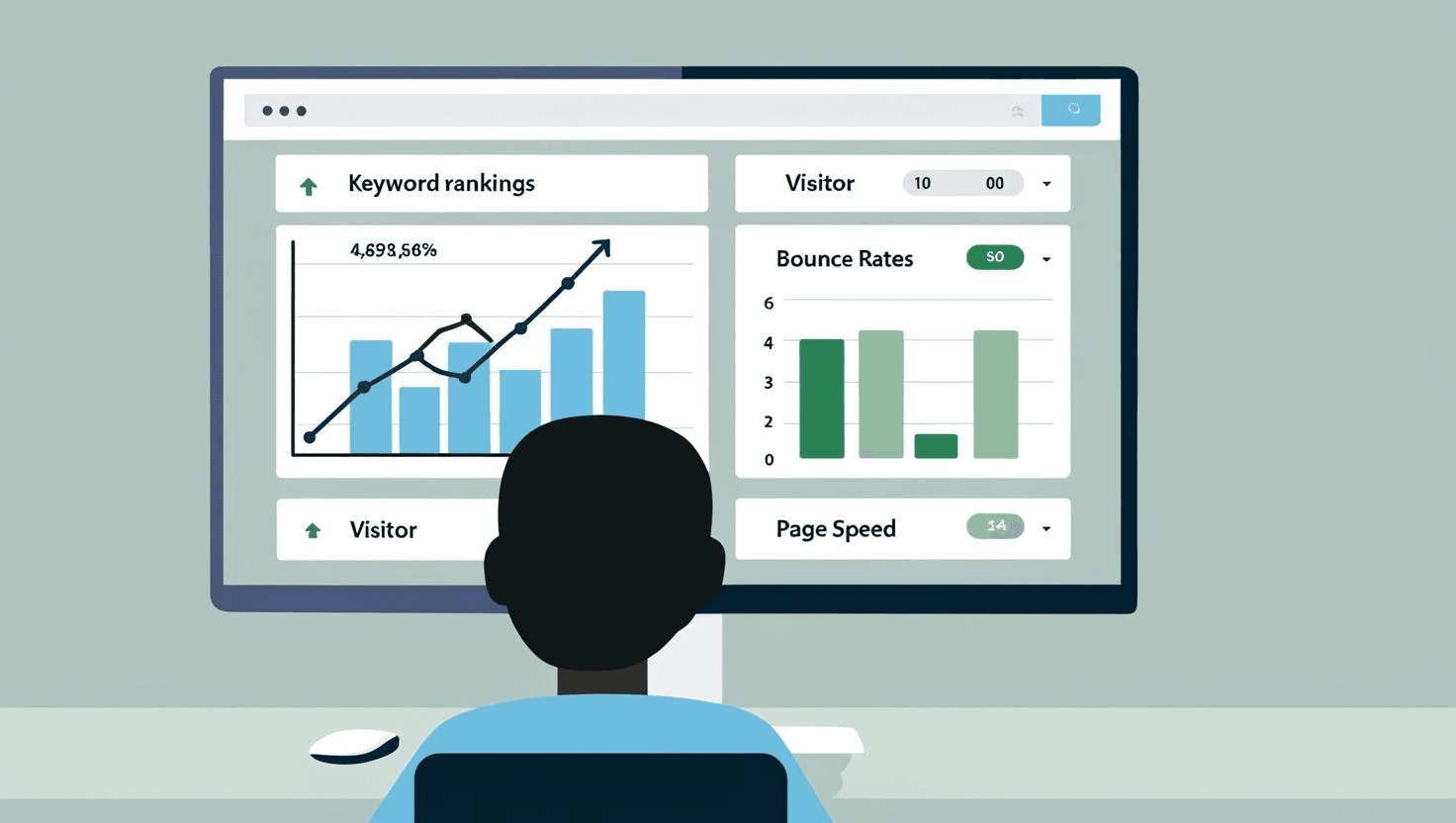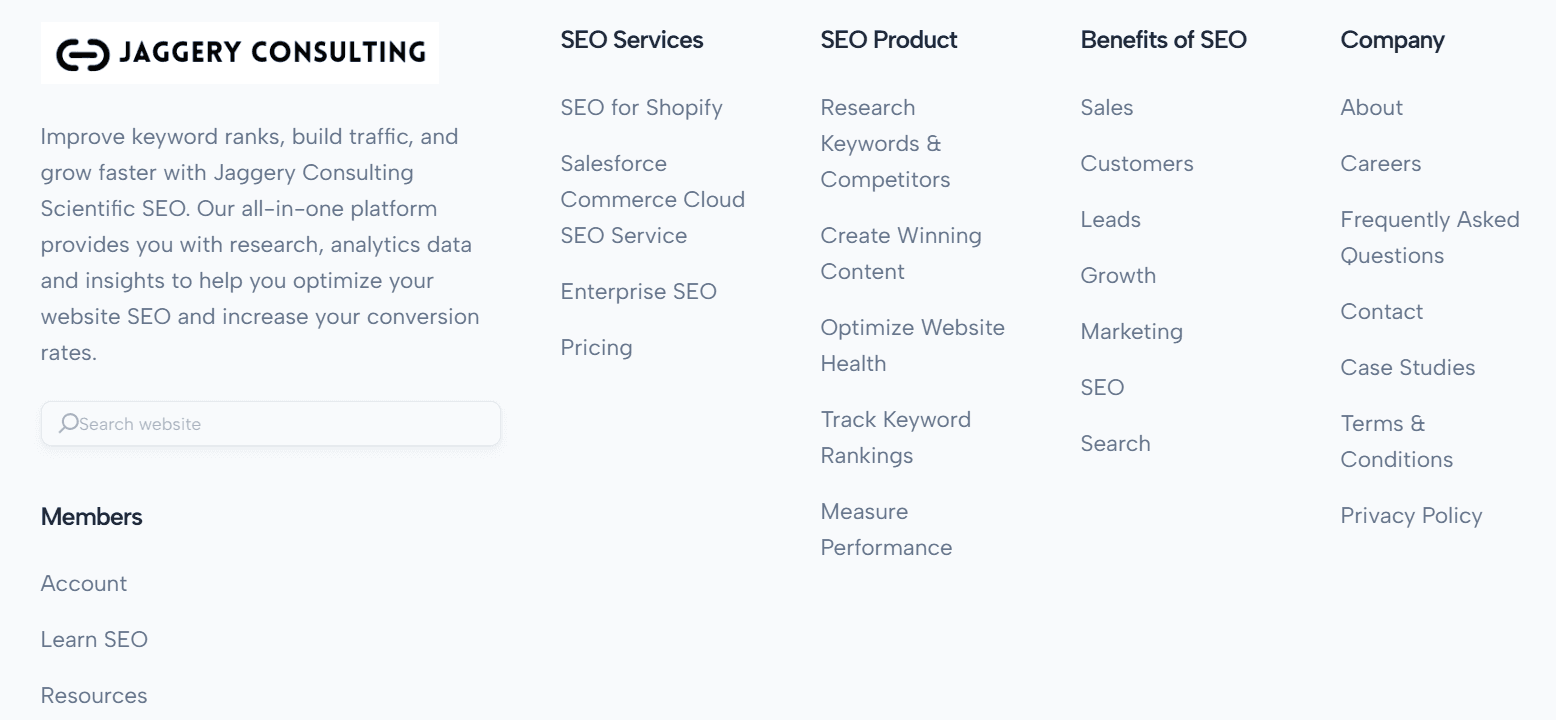What Is Real-time SEO Monitoring?
Keeping an eye on your website’s SEO in real time means constantly checking how it’s doing in search results. This helps you spot problems early and fix them fast, so your rankings and traffic don’t take a hit.
You track things like keyword positions, visitor numbers, bounce rates, and page speed.
If a keyword suddenly drops in rankings, you can step in right away and fix the issue before losing too much traffic.
Take Edelweiss Bakery, for example—they focused on SEO monitoring and saw a massive jump in their mobile organic traffic, going from 171 to 785 visits a month. That’s a 460% boost, just by staying on top of things.
Benefits of Real-Time SEO Monitoring for SEO
Watching how your website performs in real time on search engines comes with many benefits. That’s why paying attention to real-time SEO monitoring is so important.
In this section, you’ll learn four key reasons why it matters. By the end, you’ll understand why keeping track of your SEO in real time can make a big difference.
1. Immediate Issue Detection and Resolution
Keeping an eye on your website in real time is super important to catch and fix technical issues before they hurt your search rankings or frustrate visitors.
Things like broken links, crawl errors, and messy HTML can make it harder for search engines to find and understand your site.
Jaggery Consulting knows how crucial this is. They specialize in SEO audits to spot and fix problems that might slow down your site or push it down in search results. With real-time monitoring tools, they ensure everything runs smoothly so search engines can easily crawl your site, and users get a hassle-free experience.
The result? Better rankings, more traffic, and a website that works like a charm.
2. Better SEO Ranking
You're here because you want to boost your SEO ranking and show up higher on search results for your target keywords.
The key to making that happen is keeping an eye on how your website performs—both for search engines and for visitors. If something isn’t working right, fixing it can help improve your ranking. But the solution depends on which SEO metric is causing the problem.
For instance, if your ranking is low, it could be due to slow page speed or a high bounce rate.
Once you track your SEO performance and figure out that slow loading times are the issue, the steps to fix it will be different from what you'd do for a bounce rate problem.
3. Enhanced Competitive Advantage in SERP
You're not the only one trying to rank at the top of search results. Your competitors have the same goal, and they’re putting in the effort to get there. If you’re just guessing with your SEO strategy and not tracking what works, those who do it right will always stay ahead.
That’s why keeping an eye on your SEO efforts is important. It helps you figure out what’s working and what’s not.
There are also SEO tools that let you check out top-ranking competitor websites. You can see what keywords they rank for, how they structure their content, and the SEO tricks they use.
With this information, you can refine your strategy, focus on what works in your niche, and even find areas they’ve overlooked. That way, you’re not just keeping up—you’re getting ahead.
5. Prevention of Search Engine Penalties
Keeping an eye on your SEO in real-time helps you avoid getting penalized by search engines. It lets you catch and fix problems early, like bad backlinks or low-quality content that Google doesn’t like.
For example, in March 2024, Google rolled out a major update that cracked down on spammy, AI-generated content.
Many websites saw their rankings drop because they didn’t follow the rules.
By tracking SEO metrics as they change, businesses can spot issues fast, make necessary fixes, and keep their site ranking strong.
6. Data-Driven Optimization
SEO works best when it’s backed by real data instead of just guesses.
By studying things like website traffic, user activity, and conversion rates, businesses can figure out what’s working and what’s not.
This helps them make smart changes to boost rankings and keep visitors engaged.
Trying out different tactics and adjusting based on real-time results makes SEO more effective and keeps it growing over time.
7. Faster Problem Resolution
Real-time SEO monitoring helps you fix problems fast by spotting issues as soon as they happen. It instantly alerts you, so you can take action right away and keep your website running smoothly.
If your site slows down or crashes, you’ll know immediately and can fix it before too many visitors are affected.
This quick response keeps your users happy and helps protect your search rankings.
Key Metrics to Monitor in Real-Time
You’ve got a good grasp of SEO monitoring and why it matters. Now, let’s break down the key metrics you need to track, starting with content performance.
1. Organic Traffic
Organic traffic consists of visitors who reach a website through unpaid search engine results, such as those on Google or Bing. These users discover content by searching for relevant keywords and selecting a site from the listings.
Unlike paid traffic, which relies on advertisements, organic traffic is earned through effective search engine optimization (SEO). This approach improves a website’s visibility and attracts users who are actively looking for information or solutions.
Because these visitors arrive with specific interests, they are more likely to engage with the content and convert into customers.
A strong SEO strategy can lead to sustained growth, as high-quality content continues to drive traffic over time without ongoing advertising expenses.
2. Keyword Rankings
Search rankings still matter, even with all the changes Google keeps rolling out. Where your site appears in search results directly affects how many people see and click on it. That’s why keeping an eye on keyword rankings is a smart move.
Tracking your rank helps you figure out what’s working and what needs a boost. Google rewards content that shows expertise, authority, and trustworthiness (E-A-T), so making sure your pages provide real value can help them rank higher.
If your content is stuck on page two, a refresh might do the trick. But if it’s buried beyond position 50, chances are it missed the mark, and starting fresh might be your best bet.
3. Backlinks
Backlinks, also referred to as inbound links, are external hyperlinks that lead users to a specific website. These links play a crucial role in search engine optimization (SEO) by signaling a website’s credibility and authority.
When a reputable site links to a webpage, search engines view it as a positive endorsement, indicating that the content is reliable and valuable.
A strong collection of high-quality backlinks can improve a site's ranking on search engine results pages (SERPs), increasing its visibility and organic traffic.
However, not all backlinks contribute positively to SEO. Links from low-quality or irrelevant websites may have adverse effects, making it essential to focus on acquiring backlinks from authoritative and contextually relevant sources.
4. Click-Through Rate (CTR)
Click-Through Rate (CTR) shows how well online content grabs attention. It tells you what percentage of people clicked a link after seeing it.
To figure it out, just divide the number of clicks by the total views and multiply by 100. A higher CTR means more people found the content interesting enough to click.
For example, in SEO, a good organic CTR means your title and meta description are doing their job—getting users to visit your site.
Keeping an eye on CTR is important because it helps bring in more visitors, boosts engagement, and can even improve search rankings over time.
5. Impressions
Impressions tell you how often people see your website in search results. The more impressions you get, the more visible your content is.
A high count usually means your page matches popular search terms and is showing up in front of the right audience. It’s also a good sign that your site is ranking well, possibly on the first page of Google.
Keeping track of impressions helps you understand if your SEO is working and if your content is reaching the right people.
6. Bounce Rate
Bounce rate shows the percentage of visitors who land on a page and leave without clicking on anything or visiting another page.
Basically, they take a quick look and leave. A high bounce rate might mean the content isn’t what they expected, the page is slow, or the design isn’t user-friendly.
But it’s not always a bad thing! Sometimes, people find exactly what they need and leave happy. That still counts as a bounce.
So, to understand bounce rate the right way, it’s important to think about the page’s purpose and what users are looking for.
7. Conversion Rate
Conversion rate tells you how many visitors on your website actually do what you want them to—like buying something, signing up for a newsletter, or filling out a form.
It’s pretty simple to figure out:
Take the number of people who complete an action, divide it by the total visitors, and multiply by 100.
So, if 5,000 people visit your site in a month and 150 make a purchase, your conversion rate is 3%. This number helps you understand how well your SEO efforts are working. A higher conversion rate means more people are engaging with your site in a meaningful way.
Keeping an eye on this can help improve user experience, fine-tune marketing strategies, and boost revenue—all without needing more traffic.
8. Average Time on Page
Average Time on Page measures how long users stay on a particular page of a website. This metric helps assess whether visitors find the content engaging and relevant.
A high average time suggests that users are interacting with the page and exploring its content. For instance, a long read time on a blog post indicates that visitors are engaged and consuming the information. A lower time, however, may suggest that the page’s structure, clarity, or relevance to user intent needs improvement.
Not all pages are meant to hold attention for long periods. A weather forecast page, for example, serves its purpose quickly. Visitors find the information they need and move on.
The key is understanding when a shorter time is a sign of disengagement and when it simply reflects the nature of the content.
9. Dwell time
Dwell time refers to the length of time a visitor remains on a web page after clicking it from a search engine results page before navigating back.
A longer duration suggests that the content is relevant and engaging, while a brief visit may indicate that the page did not meet the user’s expectations.
Although search engines have not confirmed dwell time as a direct ranking factor, it is often associated with better SEO performance. When users spend more time on a page, it signals satisfaction, which can be beneficial for rankings.
To improve dwell time, content should be informative, well-structured, and aligned with user intent.
10. Page Load Speed
Page Load Speed is how long it takes for a website to show up completely after you click on it. It’s super important because it can make or break the user experience.
If a page takes longer to load, people are more likely to leave. For example, if a page goes from loading in 1 second to 3 seconds, 32% more people will bounce.
Also, most people (82%) say slow websites make them rethink their purchases. A lot of things affect how fast a page loads like the server’s speed, the size of images, the way the code is written, and the number of things the page needs to load.
Making your website faster isn’t just good for visitors—it helps your search ranking too, because search engines like fast pages.
11. Crawlability Errors
Crawlability errors can hurt your SEO by blocking search engines from accessing and indexing your website. If search engines can’t reach a page, it won’t show up in search results, which means fewer people will find your content.
Common crawlability issues include:
- Robots.txt Misconfigurations: Errors in the robots.txt file can inadvertently block search engines from crawling essential pages.
- Server Errors (5xx): Server-related problems can prevent search engines from accessing your site.
- Broken Links and Redirect Chains: Broken links and complex redirect chains can disrupt the crawling process, leading to incomplete indexing.
- Slow Page Load Times: Pages that load slowly can cause search engine crawlers to abandon the indexing process.
- Duplicate Content: Having identical or very similar content across multiple pages can confuse search engines and dilute page authority.
Fixing these errors helps search engines explore your site properly, making sure all your important pages get the attention they deserve.
12. Number of Pages Indexed
This metric measures how many of your website's pages have been indexed by search engines. Only indexed pages can appear in search results, making this a key factor in site visibility.
Compare the number of indexed pages to the total pages on your site. The numbers may not match exactly, as certain pages, such as log-in or security-related pages, are typically excluded from indexing.
To quickly check how many of your pages are indexed, enter the following into Google:
The search results will provide an approximate count. Regularly monitoring this data ensures that valuable content remains discoverable while also helping to identify potential issues such as duplicate content, low-quality pages, or indexing restrictions that could affect performance.
13. Internal Linking Structure
Internal links are like the roads inside a website, helping users find their way around while showing search engines which pages matter most.
When done right, they make it easier for people to explore content, keeping them on the site longer.
Search engines also benefit because a clear link structure helps them understand how pages connect, making crawling and indexing smoother.
Plus, strong pages can share their ranking power with others, helping more pages show up in search results. But if pages don’t have any internal links, they become hard to find, both for visitors and search engines.
Keeping a solid linking strategy in place makes a site easier to use and improves its chances of ranking well.
Tools and Technologies for Real-Time Monitoring
Implementing the following best practices can help ensure your SEO efforts are both proactive and impactful:
1. Define Clear Objectives
Setting clear goals is key to making real-time SEO tracking work. It keeps your SEO efforts in line with your business plans and gives you solid ways to measure success.
Take an online store, for example. If they want to boost sales, a good SEO goal might be increasing organic traffic to product pages by 25% in six months.
A goal like this is specific and easy to track, making it easier to attract the right customers and improve sales.
Without clear targets, SEO can feel scattered, and it gets tough to see if it’s actually working.
2. Utilize Advanced Monitoring Tools
Keeping an eye on your website’s SEO in real-time is super important, and advanced tools make it much easier. They automatically gather and analyze data, so you get instant updates on how your site is doing.
Jaggery Consulting, for example, helps track organic traffic, keyword rankings, and backlinks, making it simple to spot problems and new opportunities.
Google Search Console and Google Analytics also give real-time insights into user activity and website health, so you can tweak your SEO strategy on the go.
Using these tools helps you stay ahead, making sure your site keeps up with search engine updates and user trends.
3. Set Up Real-Time Alerts
Keeping an eye on your website’s SEO is super important, especially when big changes happen.
Setting up real-time alerts can help you catch issues like a sudden drop in traffic, shifts in keyword rankings, or unexpected changes in backlinks.
With tools like app.JaggeryConsulting.com, you can get instant updates, so you’re always in the loop.
Remember, the sooner you know about a problem, the faster you can fix it—keeping your site visible and running smoothly.
4. Regularly Audit and Update Content
Keeping your website fresh and up to date is super important for staying relevant and ranking well in search results. This means checking your content regularly to fix mistakes, update old info, and remove anything that’s no longer useful.
When you do this, you make sure your site gives visitors the best experience while also showing search engines that your site is active. That can help boost your rankings.
Updating content also lets you add new keywords, cover trending topics, and keep up with changes in search engine rules, making sure your site stays strong in the long run.
5. Analyze Competitor Strategies
Regularly monitoring competitors' SEO strategies is essential for maintaining strong search engine rankings.
Analyzing their keyword performance, backlink structure, and content approach provides valuable insights to refine your own strategy.
Understanding their strengths and weaknesses reveals opportunities to enhance your content and outperform them in search results. This process also keeps you informed about industry shifts and new keyword trends.
A well-executed competitor analysis ensures that your SEO efforts remain effective, adaptable, and aligned with evolving digital demands.
6. Integrate User Experience (UX) Considerations
Search engines now put a lot of focus on user experience, so keeping an eye on UX metrics is super important. Some key ones to track are bounce rate, average engagement time, and Core Web Vitals.
A high bounce rate might mean people aren’t finding what they need, which can hurt your rankings. On the other hand, if users stick around longer, it’s a good sign your content is interesting.
Core Web Vitals check things like how fast pages load and how stable they are when scrolling.
So, paying attention to these numbers helps improve user experience, which can boost rankings and make your site perform better.
7. Leverage Data for Continuous Improvement
Using data to improve SEO means keeping track of what’s working and what’s not.
By looking at how people interact with your site, checking search trends, and seeing which content gets the most attention, you can figure out what needs fixing.
This helps you tweak your SEO strategy to match what users are actually looking for. Making regular changes based on real numbers keeps your site in tune with search engine updates and user habits.
In the end, this approach helps your website rank better and attract more visitors.
Conclusion
Keeping your website visible online isn’t just a one-time thing—it’s an ongoing process. Real-time SEO monitoring helps track important stuff like keyword rankings, traffic, and user activity so you can quickly adjust and stay ahead of the competition. Catching problems early keeps them from turning into bigger issues, and it also helps spot new opportunities to grow. To make things easier, Jaggery Consulting’s AI-powered SEO tools give you real-time insights, making it simple to improve your site’s performance and get better results.
FAQs
1. How does real-time SEO monitoring enhance website performance?
Real-time SEO monitoring allows immediate detection of issues like broken links, slow page speeds, or content errors. Addressing these promptly ensures optimal user experience, maintains search engine rankings, and prevents potential traffic loss.
2. Can real-time SEO monitoring help in adapting to algorithm updates?
Yes, it provides immediate insights into performance shifts, enabling swift strategy adjustments to align with new search engine algorithms. This proactive approach helps maintain or improve rankings despite algorithm changes
3. What role does real-time monitoring play in managing backlinks?
It continuously tracks the quality and status of backlinks, identifying toxic or lost links promptly. Timely disavowal or replacement of such links preserves site authority and prevents ranking penalties.
4. How does real-time SEO monitoring impact content strategy?
By analyzing user engagement metrics as they occur, it identifies which content resonates with audiences. This data guides the creation of more targeted, effective content, enhancing user satisfaction and SEO outcomes.
5. Is real-time SEO monitoring beneficial for local SEO efforts?
Absolutely, it allows businesses to track local search performance metrics instantly, facilitating quick responses to local market trends, competitor actions, or audience behavior changes, thereby strengthening local search presence.



